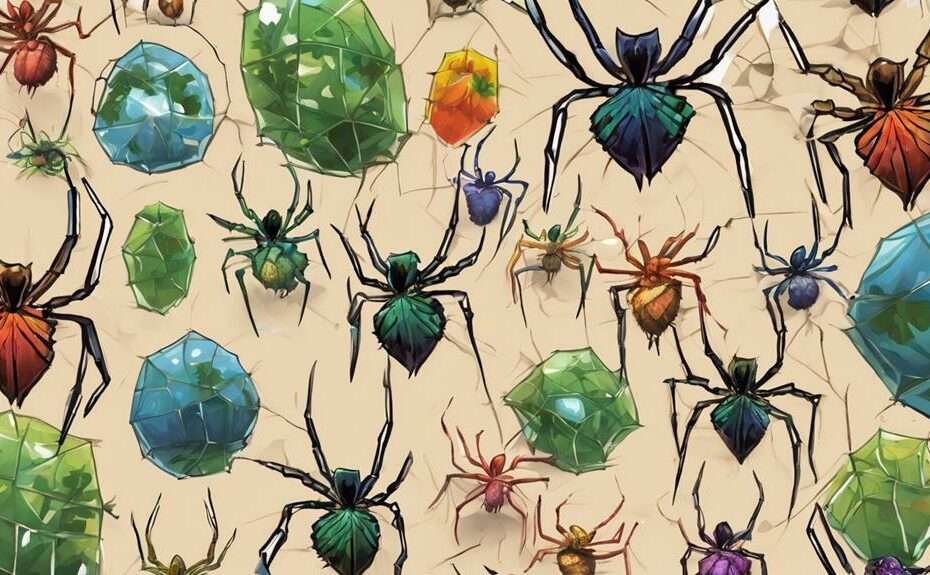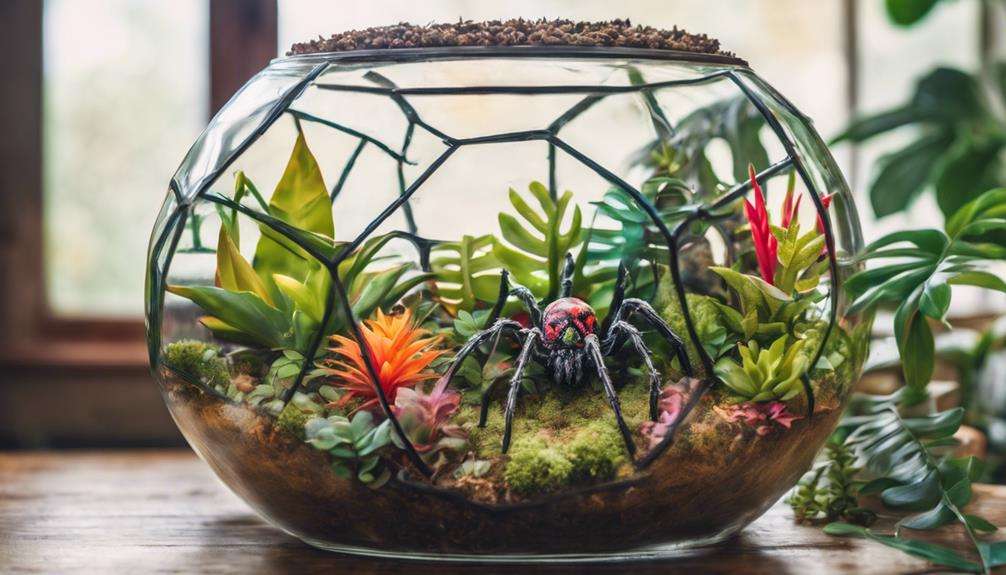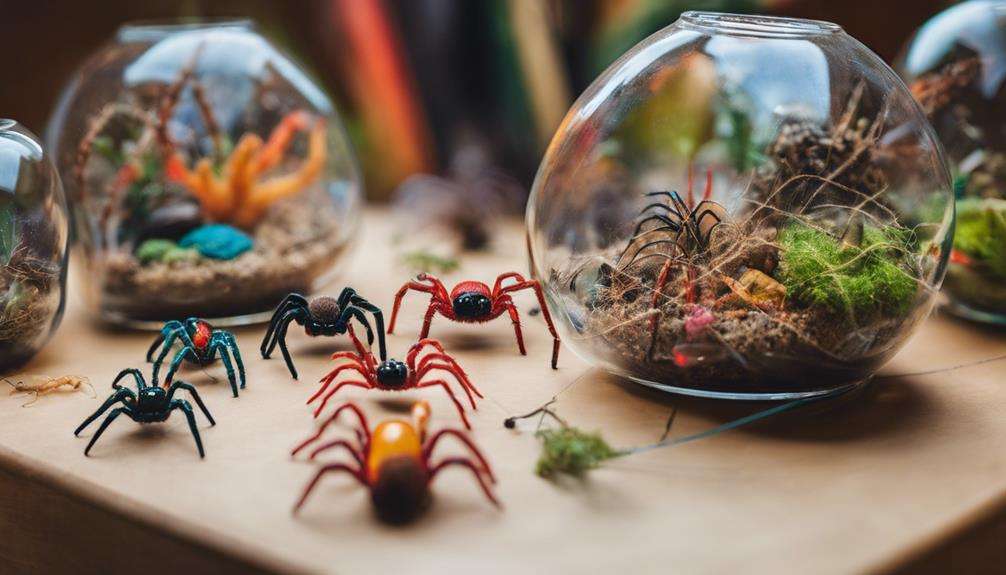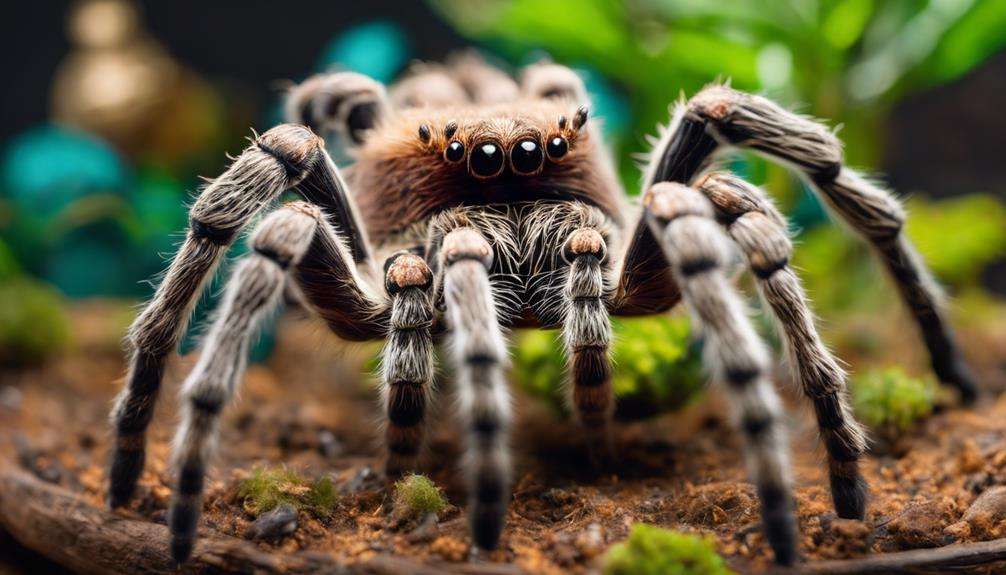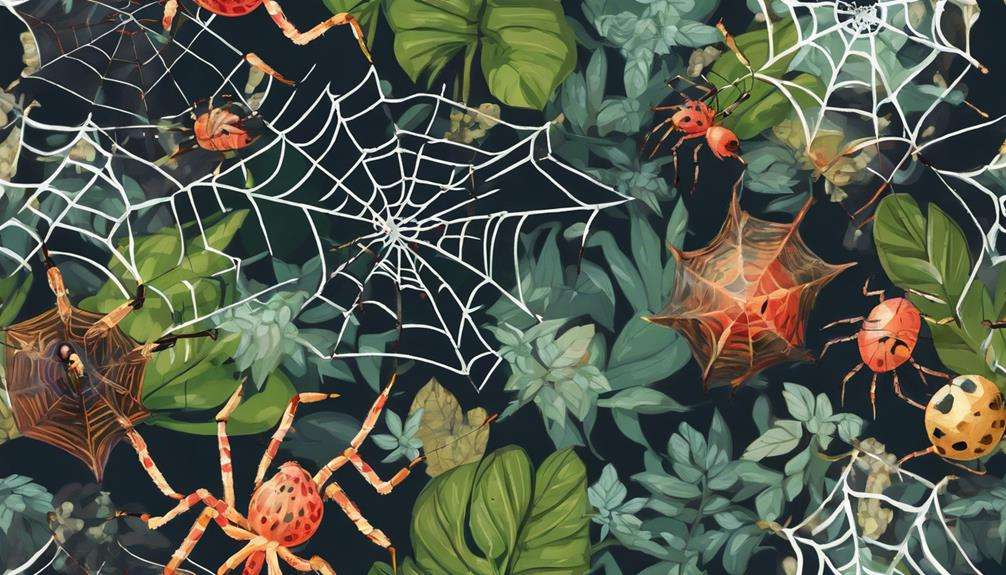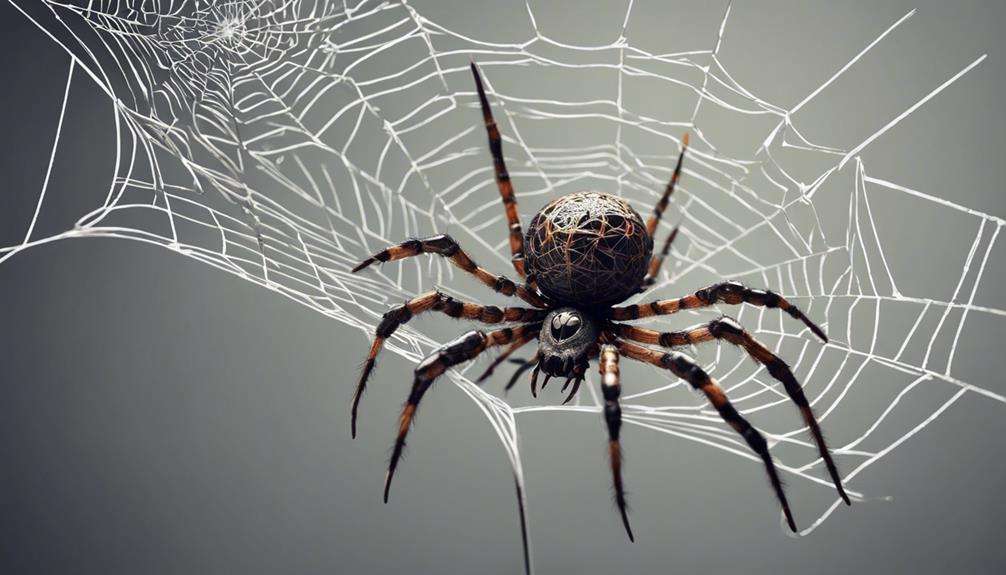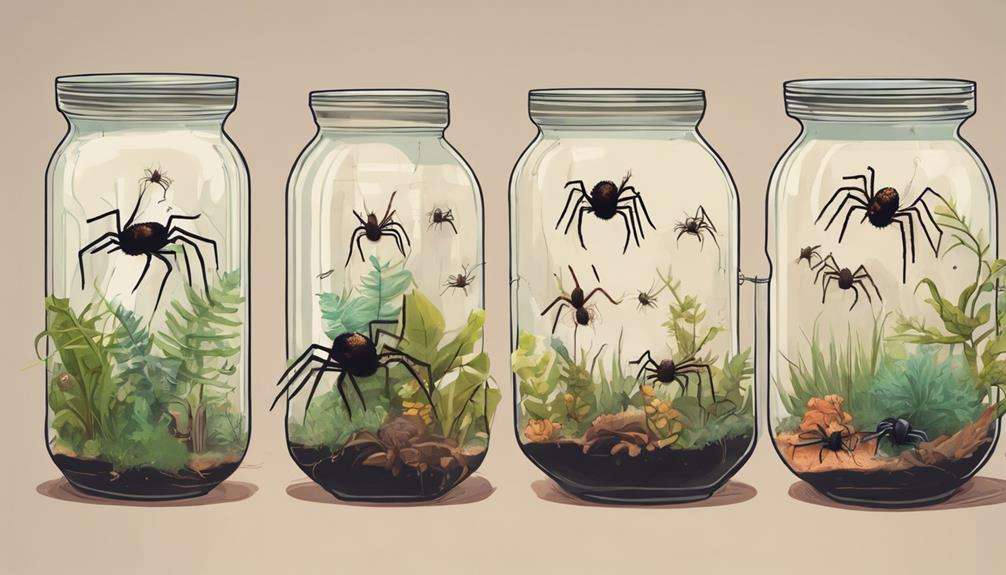Have you ever considered the allure of having a unique and intriguing pet that can captivate your attention with its mysterious nature?
Spider species, often overlooked as pets, possess qualities that make them stand out among traditional pets. From their fascinating behaviors to their low maintenance requirements, spiders offer a distinctive experience for pet owners.
But what exactly sets them apart and makes them ideal companions for those seeking something different in the domain of pet ownership?
Key Takeaways
- Low maintenance requirements and easy feeding schedules make exotic spiders convenient pets.
- Unique characteristics and behaviors of rare spider species offer captivating experiences for owners.
- Minimal cleaning and simple habitat setup reduce the burden of maintenance for spider pet owners.
- Responsibilities of ownership include providing suitable environments and monitoring health, behavior, and legal compliance.
Unique Characteristics of Rare Spider Species
Rare spider species exhibit a fascinating array of vibrant colors and unique patterns that make them visually striking pets. These rare spider species have evolved specialized adaptations that aid in their hunting or survival in their natural habitats. For example, some species have developed camouflage patterns that help them blend seamlessly into their surroundings, making them efficient predators. Others have intricate web-spinning techniques that showcase their remarkable skills in capturing prey.
In addition to their physical characteristics, rare spider species may also exhibit rare behaviors that are captivating to observe in a captive setting. Some species display intricate courtship rituals, while others showcase unique methods of communication through vibrations or pheromones. These behaviors provide enthusiasts with an opportunity to witness the complexity and diversity of arachnid behaviors up close.
Low Maintenance Requirements for Exotic Spiders
Exotic spiders, such as tarantulas, offer low maintenance requirements due to their easy feeding schedules, simple habitat setup, and minimal cleaning needs.
Once you've established the correct heat and humidity levels, maintaining these parameters becomes a straightforward task.
Feeding your exotic spider a couple of crickets per week is a cost-effective and convenient way to meet their dietary needs.
Easy Feeding Schedules
Feeding schedules for most spider species, including tarantulas, typically involve one to two crickets per week, simplifying the task of managing their nutritional needs. These low maintenance requirements make spiders an ideal pet choice.
Crickets are easily accessible, either free-ranging or from a butcher, to fulfill the dietary needs of pet spiders. Some specific spider species may benefit from alternative food sources like center-cut cricket loin.
Understanding the feeding requirements of your spider is essential for maintaining their health and well-being. By adhering to these easy feeding schedules, you can make sure that your exotic spider thrives as a pet with minimal effort on your part.
Simple Habitat Setup
With their simple habitat requirements, exotic spiders can thrive in basic terrariums that facilitate easy cleaning and maintenance routines. These low maintenance pets often do well in minimalistic habitats that reduce the need for complex environmental controls.
Beginner pet owners looking for a straightforward setup will find that simple habitat setups suit various exotic spider species. Basic terrariums with minimal decoration not only provide a suitable living space but also contribute to the overall well-being of the spiders.
Such habitats make it convenient for owners to clean and care for their exotic pets regularly. Easy cleaning routines are essential for maintaining a healthy environment for these fascinating creatures, ensuring they thrive in captivity.
Minimal Cleaning Needed
Spider species with low maintenance requirements for cleaning exhibit minimal waste production due to their efficient digestive systems. Tarantulas, for example, defecate infrequently, reducing the frequency of enclosure cleanings. Their efficient metabolism results in less waste, making them ideal low-maintenance pets.
Additionally, the lack of odor associated with tarantulas simplifies cleaning tasks compared to other animals. These factors contribute to the overall ease of caring for spider species, making them ideal exotic pets for individuals seeking pets that require minimal cleaning.
The combination of efficient digestive systems and infrequent waste production not only reduces the time and effort required for maintenance but also creates a more pleasant environment for both the pet owner and the spider.
Fascinating Behaviors of Pet Spider Species
Orb-weaving, roaming, jumping, corner web, and burrowing spiders exhibit a diverse array of fascinating behaviors that are unique to each species when kept as pets.
Orb-weaving spiders showcase intricate web-building behaviors, meticulously crafting symmetrical webs within their tanks.
Roaming and jumping spiders employ agile movements and precise strikes as part of their hunting methods, displaying remarkable prowess in capturing prey.
Corner web spiders exhibit specific preferences for web placement, often choosing strategic locations within their habitat to construct their webs.
Burrowing spiders engage in tunneling behaviors, creating elaborate underground dwellings that reflect their secretive nature.
These behaviors offer insights into the diverse strategies spiders employ for prey capture, with each species demonstrating a distinct approach to hunting.
Understanding and observing these behaviors can provide spider enthusiasts with a deeper appreciation for the complexity and sophistication of these fascinating arachnids.
Safety Considerations When Keeping Uncommon Spiders
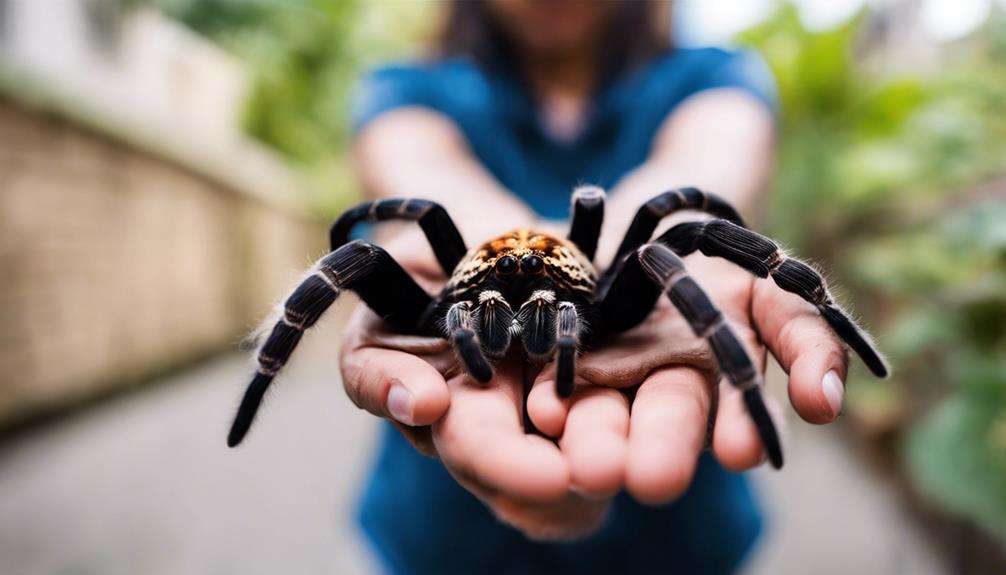
When handling venomous spider species, it's critical to guarantee secure enclosures and proper precautions to minimize the risk of accidental exposure to toxins.
Understanding the specific venom properties and behavior of uncommon spiders is essential to prevent any potential harm.
Seek advice from experienced individuals to guarantee the safe care and handling of these unique arachnids.
Handling Venomous Spider Species
Handling uncommon venomous spider species necessitates meticulous safety precautions to mitigate the risks associated with their potent venom. When dealing with venomous spiders like the Brazilian wandering spider or the Sydney funnel-web spider, it's essential to implement safety measures such as using long-handled tools, wearing protective gloves, and avoiding direct contact to prevent potential bites.
Venomous spider bites can lead to severe reactions in humans, ranging from pain and swelling to life-threatening consequences. Seeking professional guidance or assistance from experienced individuals is highly recommended to guarantee safety and minimize the risk of accidental exposure to dangerous toxins.
Understanding the specific venom properties and behaviors of uncommon spider species is essential for safe interaction and proper management to prevent harm or adverse effects.
Ensuring Secure Enclosures
To guarantee the safety and containment of uncommon spiders, it's imperative to establish secure enclosures that prevent potential escapes and minimize risks associated with handling them. Spiders, capable of squeezing through tiny cracks, require enclosure lids that fit tightly to prevent escapes.
When feeding, make sure a secure method to drop food inside without creating opportunities for spiders to escape. Pay close attention during feeding and watering to prevent accidental escapes, as disturbances can prompt escape attempts.
Handling uncommon spiders should be approached with caution, as stress may lead to bites or escape attempts. Especially with venomous species, which can cause mild to severe reactions, safety measures are critical to prevent illness or death when keeping these unique arachnids.
Benefits of Owning a Rare Pet Spider
Rare pet arachnids offer a one of a kind chance for enthusiasts seeking exotic and uncommon additions to their collection. These rare pet spider species can bring a unique flair to your hobby, standing out as conversation starters among fellow enthusiasts. Their exotic nature not only adds diversity to your collection but also piques the interest of those around you.
While some rare pet spiders may come with special care requirements, experienced keepers find the challenge rewarding. The need for specific care routines adds an element of intrigue and satisfaction when successfully met. Additionally, investing in a rare pet spider could potentially lead to an increase in value over time due to their scarcity in the market. This aspect not only enhances the appeal of owning such a unique creature but also offers the possibility of a valuable return on your investment.
Challenges of Caring for Unique Spider Species
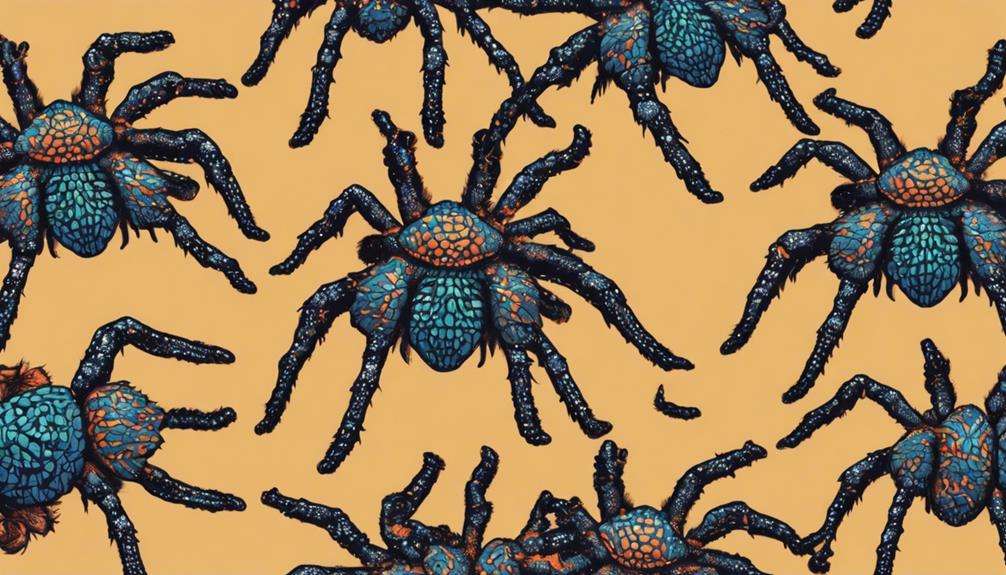
Caring for unique spider species presents intricacies that demand meticulous attention to detail and adherence to specific environmental requirements. Some exotic spider species have specialized diets, requiring owners to carefully source appropriate food, which can pose a challenge. Additionally, the venomous nature of certain rare spiders means that handling them carries inherent risks due to potential defensive behaviors. Legal considerations must also be taken into account, as ownership of exotic spider species may require permits in specific regions.
Moreover, these unique spider species may have shorter lifespans or be more sensitive to environmental changes, necessitating extra care and attention. Ensuring that the temperature, humidity, and habitat setup meet the specific needs of these spiders can be demanding. Any alterations to their environment must be made cautiously, as even slight changes could have detrimental effects on their well-being. Caring for exotic spider species requires a thorough understanding of their requirements and a commitment to providing a suitable and safe environment.
Frequently Asked Questions
What Makes a Spider a Good Pet?
When considering a spider as a pet, it is crucial to understand their specific needs. Handling spiders requires care and delicacy. Establish a regular feeding routine, set up a suitable enclosure, and observe their unique behavioral traits. Bonding with spiders takes time and patience.
Do Some Spiders Like to Be Pet?
Spiders' preferences for petting vary; some species tolerate gentle handling and signal comfort through calm behavior. Observing their body language is essential. Understanding spider behavior, communication, habitats, and proper care is essential for responsible ownership.
What's the Friendliest Spider?
When considering the friendliest spider, the Chilean Rose Tarantula stands out. Their docile nature, easy handling, and calm temperament make them ideal for beginners. Their beautiful color variations and visible activity enhance the bonding experience with interactive playtime.
Are Spiders High Maintenance Pets?
Spiders vary in maintenance needs. Feeding frequency, housing requirements, handling safety, cleaning responsibilities, and cost considerations differ among species. Understanding these aspects is essential for proper care and ensuring a suitable pet for you.
Conclusion
To summarize, owning a rare spider species as a pet can offer you a fascinating and educational experience. From observing their unique behaviors to meeting their specific maintenance requirements, these exotic pets can bring joy and wonder into your life.
Just like a spider weaving its intricate web, owning a rare pet spider can weave a tapestry of knowledge and entertainment that will captivate you for years to come.
